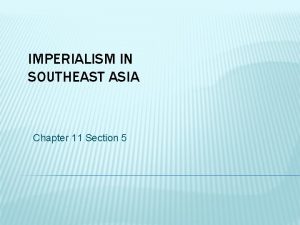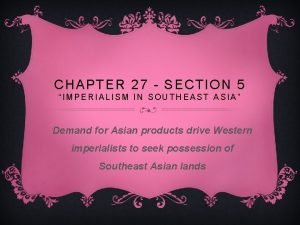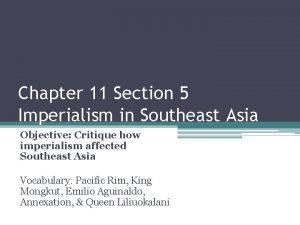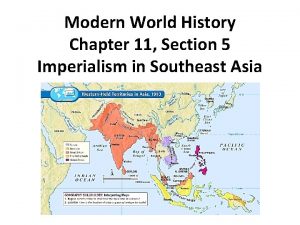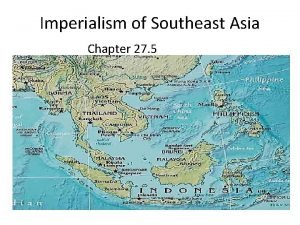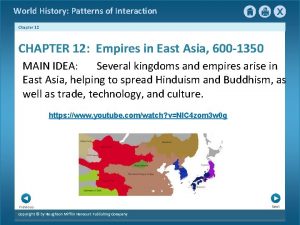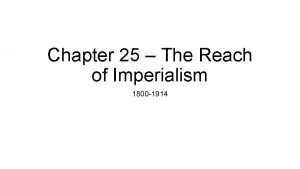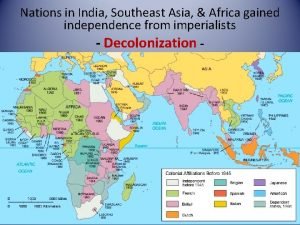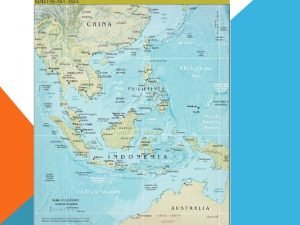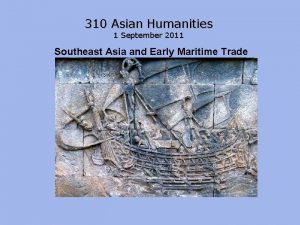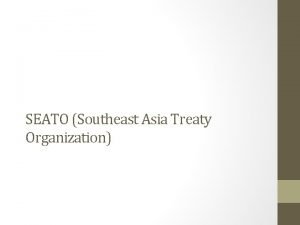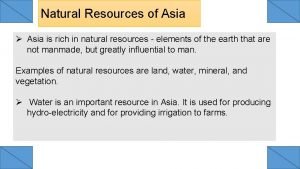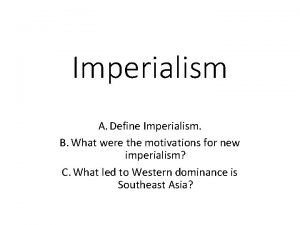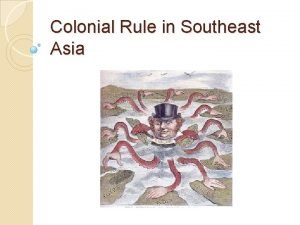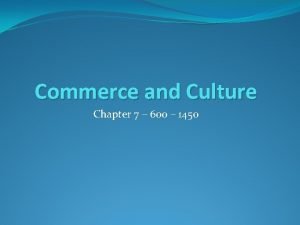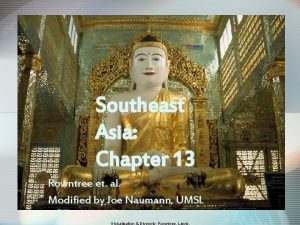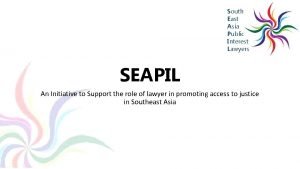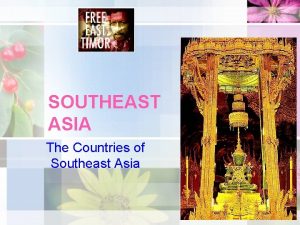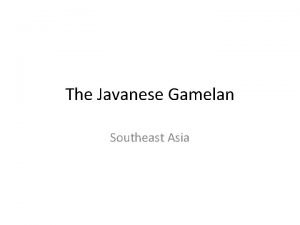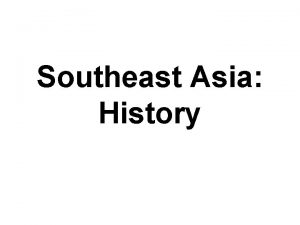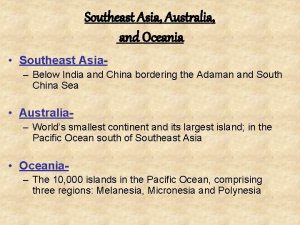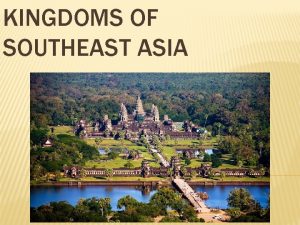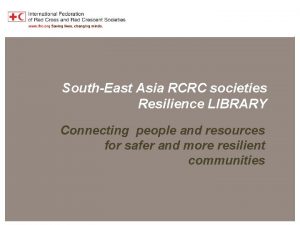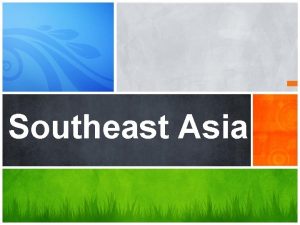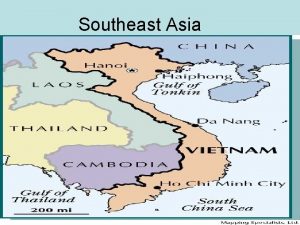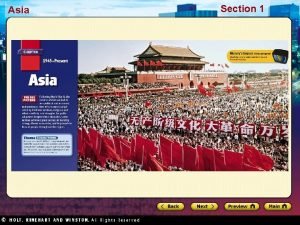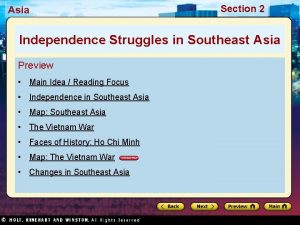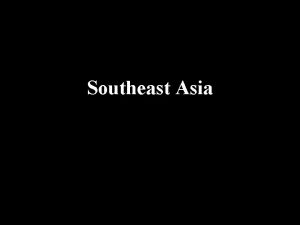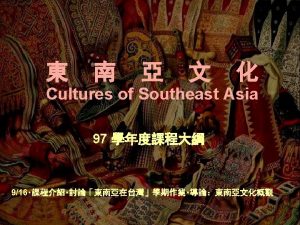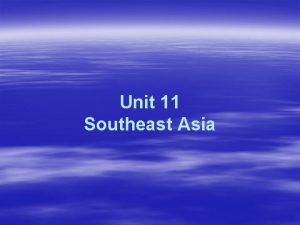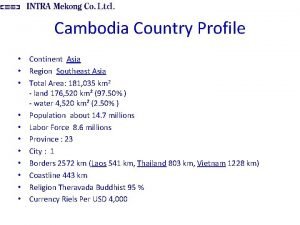CHAPTER 6 SECTION 3 SOUTHEAST ASIA IN THE






















- Slides: 22

CHAPTER 6, SECTION 3: SOUTHEAST ASIA IN THE ERA OF THE SPICE TRADE Section 6. 3 outline & Questions – p. 201 -204 6. 3 Outline – finish today 6. 3 questions – due Thursday TOMORROW PSAT


CHAPTER 6, SECTION 3: SOUTHEAST ASIA IN THE ERA OF THE SPICE TRADE 1. Go over Section 6. 3 outline & Questions 2. Trade routes map Students will create a map of spice and slave trade routes.

SECTION 6. 3 – SPICE TRADE IN SOUTHEAST ASIA


EMERGING MAINLAND STATES A. In 1500, mainland Southeast Asia was relatively stable. From Burma to Vietnam, kingdoms with their own ethnic, linguistic, and cultural characteristics were being formed. B. Conflicts did erupt between the emerging states. Burma and Thailand clashed. The Vietnamese began their “March to the South. ” By the end of the fifteenth century, they subdued the rival state of Champa. They then took control of the Mekong delta from the Khmer, a monarchy that virtually disappeared by 1800.

EMERGING MAINLAND STATES C. Muslim merchants penetrated the Malay Peninsula and the Indonesian archipelago. The major impact of Islam came in the fifteenth century with the rise of the new sultan at Melaka was powerful because of its strategic location and the spice trade’s rapid growth. Melaka shortly became the leading power in the region.

EMERGING MAINLAND STATES D. The European success in creating trading empires in the East and conquering the Americas owed much to the use of gunpowder/guns and cannons. For example, the heavy cannon of the Portuguese ships made defeating the lighter Muslim fleets easy. The Ottoman and Safavid Empires also used gunpowder effectively, causing historians to label them and others “gunpowder

THE ARRIVAL OF EUROPEANS A. In 1511, the Portuguese seized Melaka and soon occupied the Moluccas, or Spice Islands. They were the chief source of the spices that attracted the Portuguese to the Indian Ocean.

THE ARRIVAL OF EUROPEANS B. The Portuguese were able to establish only trading posts and way stations en route to the Spice Islands. That situation changed with the arrival of the English and Dutch traders, who were better financed than the Portuguese. In the early 1600 s, the Dutch gradually pushed the Portuguese out of the spice trade. The Dutch also drove the English out of the spice trade. The English were reduced to one port on the coast of Sumatra, and the Dutch occupied most of the formerly Portuguese forts along the trade routes, including Ceylon (present-day Sri Lanka).

THE ARRIVAL OF EUROPEANS C. The Dutch began to consolidate their political and military control over the entire area. They brought the island of Java under their control and established a fort there to protect their possessions in the East. They used tactics such as trying to dominate the clove trade by limiting cultivation to one island forcing others to stop growing and trading the spice.


THE ARRIVAL OF EUROPEANS D. Europeans had less impact on the Southeast Asian mainland than on the Malay Peninsula and Indonesia. The Portuguese established limited trade relations with several mainland states (part of the continent, as opposed to peninsulas and offshore islands), including Thailand, Burma, Vietnam, and what remained of the old Angkor kingdom in Cambodia. European states also tried to gain missionary privileges. The mainland states generally were able to unite and drive the Europeans out.

THE ARRIVAL OF EUROPEANS E. Civil war in Vietnam temporarily divided the country into two separate states. By the midseventeenth century, Europeans began to take sides in local politics. Soon, however, it became clear that the economic opportunities were limited and many Europeans pulled out. French missionaries tried to stay, but they were blocked in their efforts by authorities who saw Catholicism as a threat to the prestige of the Vietnamese emperor.

THE ARRIVAL OF EUROPEANS F. The mainland states of Burma, Thailand, and Vietnam were able to resist the Europeans partly because they had strong monarchies that resisted foreign intrusion. Non-mainland states had less political unity. They were also victims of the fact that they were so rich in the spices that the Europeans coveted.

RELIGIOUS AND POLITICAL SYSTEMS A. Between 1500 and 1800 religious beliefs changed in Southeast Asia. Islam and Christianity made converts in the non-mainland states and the Philippines. Buddhism was advancing in the mainland became dominant from Burma to Vietnam. B. Politically, Southeast Asia evolved into four styles of monarchy: Buddhist, Javanese, Islamic, and Vietnamese.

RELIGIOUS AND POLITICAL SYSTEMS The Buddhist style of kingship became the chief form of government in Burma, Thailand, Laos, and Cambodia. The king was considered superior to other human beings, serving as the link between human society and the universe. D. Javanese kingship was rooted in Indian political traditions. Like Buddhist kings, Javanese rulers were believed to have a sacred quality, maintaining the balance between the material and spiritual worlds. The palace was designed to represent the center of the universe C.

RELIGIOUS AND POLITICAL SYSTEMS E. Islamic sultans on the Malay Peninsula and some islands of the Indonesian archipelago were viewed as mortal, though with special qualities. They were defenders of the faith and staffed the bureaucracy—a body of nonelective government officials—with aristocrats. F. Vietnamese kingship followed the Chinese model. The Vietnamese emperor ruled by Confucian principles. He was seen as a mortal appointed by Heaven to rule because of his talent and virtue. He also was an intermediary between Heaven and Earth.

TRADE ROUTES MAP • Include the following country’s trading routes on your map: Spain – red or pink England – blue or purple Portugal - green The Netherlands – orange or yellow • Read through your notes and record each instance of trade that is mentioned in the chapter. use pgs. 194 (read about Spain), 198 & 203 • Include both the Spice Trade and Slave Trade (solid lines for slaves, dashed lines for spices), dotted lines for gold/Silver) • Label the countries/regions / continents that were involved with the trade: -European countries -African regions -Ottoman Empire -Southeast Asia

BUREAUCRACY

INTRODUCTION

 Chapter 11 section 5 imperialism in southeast asia
Chapter 11 section 5 imperialism in southeast asia Imperialism in southeast asia chapter 27 section 5
Imperialism in southeast asia chapter 27 section 5 Chapter 11 section 5 imperialism in southeast asia
Chapter 11 section 5 imperialism in southeast asia Chapter 11 section 5 imperialism in southeast asia
Chapter 11 section 5 imperialism in southeast asia Chapter 27 section 5 imperialism in southeast asia
Chapter 27 section 5 imperialism in southeast asia Chapter 12 section 5 kingdoms of southeast asia and korea
Chapter 12 section 5 kingdoms of southeast asia and korea The reach of imperialism
The reach of imperialism Southeast asia model
Southeast asia model Landforms of the southwest
Landforms of the southwest Mainland se asia
Mainland se asia Is india southeast asia
Is india southeast asia Mon khmer
Mon khmer Chapter 15 lesson 1 physical geography of north africa
Chapter 15 lesson 1 physical geography of north africa Southeast asian alphabets
Southeast asian alphabets Southeast asia treaty organization
Southeast asia treaty organization Natural resources in southeast asia
Natural resources in southeast asia What led to western dominance in southeast asia?
What led to western dominance in southeast asia? Colonial rule in southeast asia
Colonial rule in southeast asia Spice chart
Spice chart Sea roads as a catalyst for change southeast asia
Sea roads as a catalyst for change southeast asia Countries in southeast asia
Countries in southeast asia Countries in southeast asia
Countries in southeast asia Customs lawyers southeast asia
Customs lawyers southeast asia
